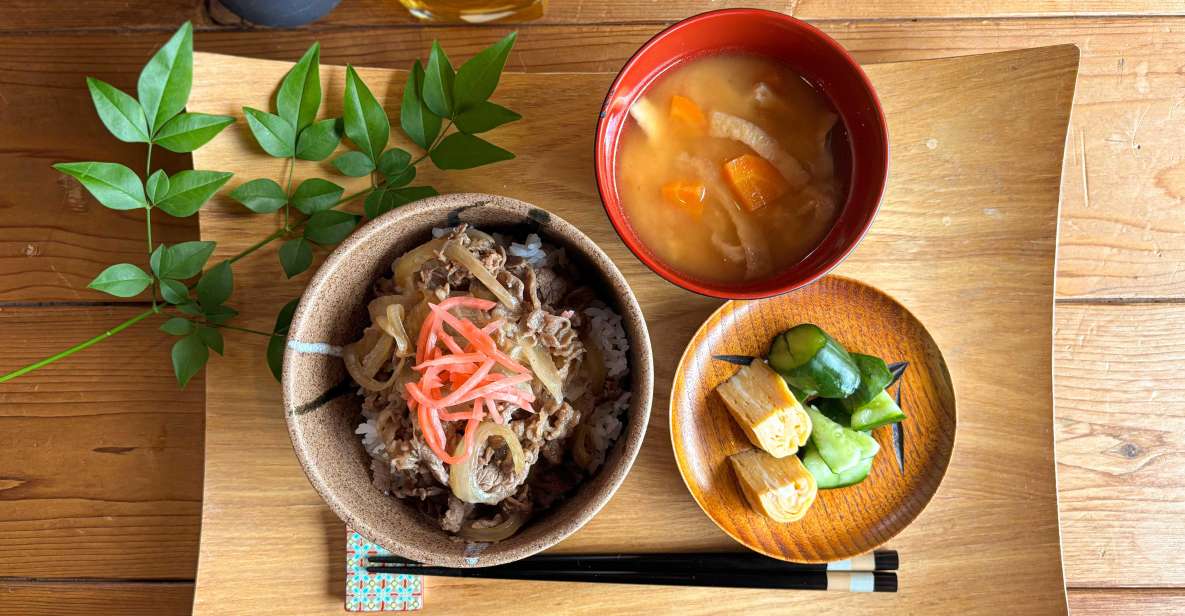In the heart of Tokyo, a salaryman rushes into a cozy eatery after a long day at work and orders a steaming bowl of Gyudon. This iconic Japanese dish, featuring thinly sliced beef simmered in a sweet and savory sauce, served over a bed of fluffy rice, is a staple comfort food revered by locals and visitors alike.
But what makes Gyudon so irresistible, and how does it captivate the taste buds of millions worldwide? As the aroma of simmering beef fills the air, let’s uncover the secrets behind this ubiquitous Japanese beef rice bowl and its tantalizing side dishes that complement its flavors perfectly.
Just The Basics
- Learn to cook Gyudon, a traditional Japanese beef rice bowl, from scratch in a 2-hour class.
- Discover the art of making miso soup, pickled vegetables, and tamagoyaki as side dishes.
- Experience hands-on cooking with an English-speaking instructor in Tokyo’s Kanto region.
- Enjoy an authentic Japanese home cooking workshop with ingredients provided and beverages included.
Here's some other great tours and experiences nearby we think you'll like.
History of Gyudon

Originating in Japan, Gyudon, a beloved dish of simmered beef and onions atop a bed of rice, has a rich culinary history that dates back to the late 1800s. This iconic dish is deeply rooted in Japanese cuisine, showcasing the perfect harmony of tender beef slices and sweet onion flavors.
Originally known as ‘Gyudon,’ meaning beef bowl, this dish quickly gained popularity due to its affordability and delicious taste. Gyudon’s history intertwines with Japan’s evolving food culture and the growing appreciation for hearty, flavorful meals.
Over the years, Gyudon has become a staple comfort food for many, reflecting the essence of traditional Japanese home-cooked meals while highlighting the significance of beef in Japanese culinary traditions.
Ingredients for Gyudon
For making Gyudon, the essential ingredients include thinly sliced beef, onions, soy sauce, mirin, and dashi broth. Gyudon is a nutritious dish, providing a balanced mix of protein, carbohydrates, and essential vitamins and minerals. When it comes to Gyudon toppings, common choices include pickled ginger, beni shoga (red pickled ginger), and shichimi togarashi (Japanese seven-spice blend) for an extra kick of flavor. Here is a breakdown of the key Gyudon toppings:
| Toppings | Description |
|---|---|
| Pickled Ginger | Adds a tangy flavor |
| Beni Shoga | Brings a vibrant color |
| Shichimi Togarashi | Provides a spicy kick |
These toppings complement the savory taste of Gyudon and enhance the overall dining experience.
Cooking Process for Gyudon
To prepare Gyudon, begin by thinly slicing the beef and finely chopping the onions. In a pan, cook the beef until browned, then add the onions. Pour in a mixture of soy sauce, mirin, sake, and dashi broth for a flavorful broth.
Traditional techniques involve simmering the beef and onions in the broth until the flavors meld together perfectly. Once cooked, serve the Gyudon over a bowl of steamed rice.
The cooking process is straightforward and budget-friendly, making it a popular choice for homemade Japanese meals. The key lies in the balance of sweet and savory flavors in the broth, enhancing the overall taste of this beloved dish.
Variations of Gyudon
After mastering the traditional Gyudon cooking process, exploring various creative twists and adaptations can further enhance your culinary experience. When it comes to Gyudon variations, presentation plays a significant role in elevating the dish. Here are some Gyudon recipe tips to help you experiment with different flavors and styles:
| Variation | Ingredients | Presentation |
|---|---|---|
| Spicy Gyudon | Chili flakes, garlic, soy sauce | Top with a fried egg for a rich finish |
| Teriyaki Gyudon | Teriyaki sauce, sesame seeds | Garnish with green onions and sesame seeds |
| Miso Gyudon | Miso paste, sugar, mirin | Sprinkle with seaweed strips for a Japanese touch |
| Curry Gyudon | Curry roux, carrots, potatoes | Serve with pickled ginger for a flavor contrast |
| Mushroom Gyudon | Assorted mushrooms, sake, butter | Drizzle with truffle oil for a luxurious touch |
Side Dishes for Gyudon
Exploring complementary side dishes can enhance the overall dining experience of enjoying Gyudon, offering a variety of flavors and textures to accompany the savory beef and rice bowl. When looking for side dishes to pair with Gyudon, consider these options:
-
Miso Soup: A classic Japanese dish that complements Gyudon perfectly with its umami-rich broth and tofu or seaweed additions.
-
Tsukemono (Pickled Vegetables): These tangy and crunchy pickles add a refreshing contrast to the rich flavors of Gyudon, cleansing the palate between bites.
-
Goma-ae (Sesame Spinach Salad): This simple yet flavorful salad, made with blanched spinach and a sesame dressing, brings a light and nutty element to balance the meal.
These traditional Japanese side dishes can be easily prepared at home, enhancing your Gyudon experience without breaking the bank.
Health Benefits of Gyudon

Enhance your culinary experience by discovering the health benefits of Gyudon, a traditional Japanese beef rice bowl dish. Gyudon offers various benefits due to its nutritious components.
This dish is rich in protein from the beef, essential for muscle growth and repair. Plus, Gyudon contains a good amount of carbohydrates from the rice, providing energy for daily activities.
The flavors of Gyudon are well-balanced, with the savory umami taste from the beef and the sweetness of the onions complementing each other perfectly.
In terms of preparation, Gyudon is relatively simple to make, making it a convenient and healthy meal option for individuals looking to enjoy a tasty dish packed with essential nutrients.
Gyudon in Japanese Culture
Discover the cultural significance of Gyudon in Japan through its widespread popularity and historical roots. Gyudon holds a special place in Japanese culture, reflecting traditions and flavors passed down through generations. Here are three reasons why Gyudon is deeply ingrained in Japanese society:
-
Comfort Food: Gyudon is a go-to comfort meal for many Japanese people, offering a warm and satisfying experience reminiscent of home-cooked meals.
-
Quick and Convenient: Its quick preparation and affordable price make Gyudon a staple in Japanese fast-food culture, catering to busy individuals seeking a tasty and filling meal on the go.
-
Symbol of Unity: Enjoying Gyudon together fosters a sense of community and togetherness, symbolizing shared experiences and the importance of coming together over a delicious meal.
Where to Enjoy Gyudon
For an authentic and budget-friendly Gyudon experience, head to traditional Japanese eateries known as ‘Yoshinoya’ or ‘Matsuya.’ These chains are popular for serving delicious Gyudon bowls topped with thinly sliced beef and onions simmered in a savory sauce, all served over a bed of steaming white rice.
Some of the best toppings to enhance your Gyudon experience include a perfectly cooked soft-boiled egg, pickled red ginger known as beni shoga, and a sprinkle of shichimi togarashi for a spicy kick. These toppings add layers of flavor and texture to the dish without breaking the bank.
Frequently Asked Questions
Can I Request a Vegetarian or Vegan Option for the Gyudon Cooking Class?
For the Gyudon cooking class, participants cannot request vegan alternatives. The class focuses on traditional beef rice bowl preparation. For plant-based options, individuals may explore culinary creativity at home by making flavorful substitutions.
Are There Any Specific Dietary Restrictions or Allergies That the Cooking Instructor Should Be Made Aware of Before the Class?
Before the class, inform the instructor of any dietary preferences or food allergies. Traditional ingredients like beef and miso are used. It’s essential to communicate any restrictions to ensure an enjoyable and safe cooking experience.
Is There a Dress Code or Any Specific Attire That Participants Should Wear for the Cooking Class?
There isn’t a specific dress code for the cooking class, but it’s recommended to wear comfortable attire suitable for cooking. Understanding basic cultural etiquette and being open to learning new cooking techniques will enhance the experience.
Are There Any Specific Kitchen Tools or Equipment That Participants Need to Bring to the Cooking Class?
Participants do not need to bring kitchen essentials; all tools and equipment are provided. The class covers cooking techniques for Gyudon and side dishes. Ingredient substitutions and flavor profiles are discussed during the hands-on lesson.
Is There a Minimum Age Requirement for Participants to Attend the Gyudon Cooking Class?
There is no minimum age requirement for the Gyudon cooking class. However, the activity is not suitable for children under 3 years old. Participants with dietary restrictions like vegans may need to opt out due to the beef-based nature of Gyudon.
Final Words
To sum it up, Patias Japanese Cooking Class offers a budget-friendly opportunity to learn how to make the delicious Gyudon beef rice bowl and side dishes in Tokyo.
With a focus on quality ingredients and expert guidance, participants can enjoy a hands-on experience in traditional Japanese home cooking.
Don’t miss out on this chance to learn about the flavors and culture of Japan through this interactive culinary workshop.
